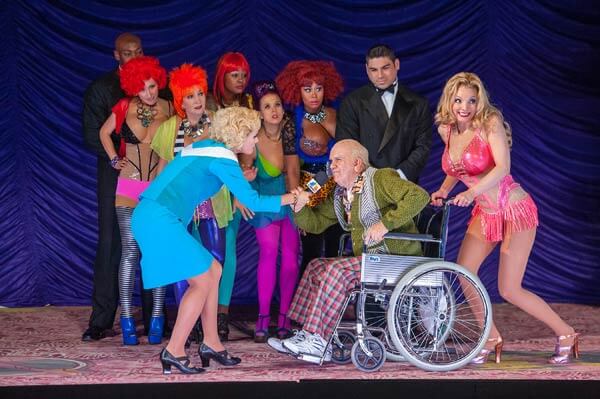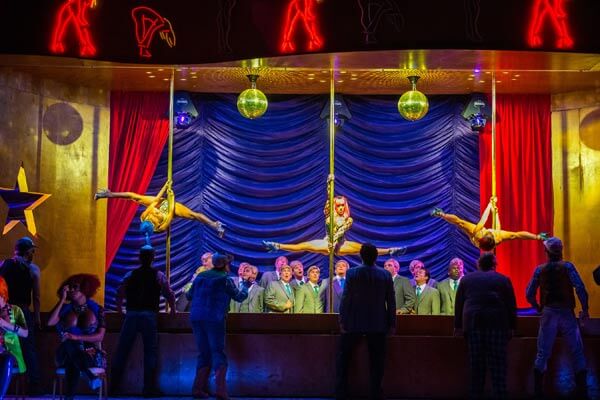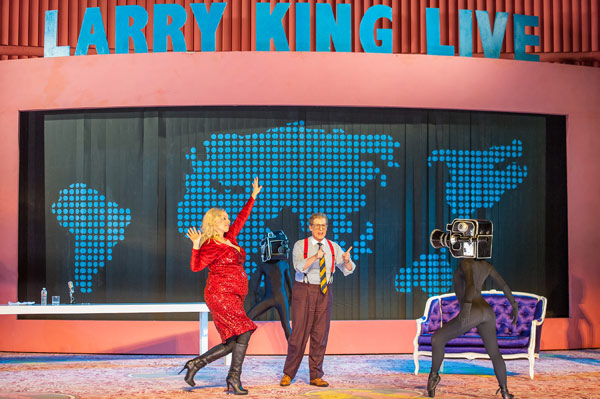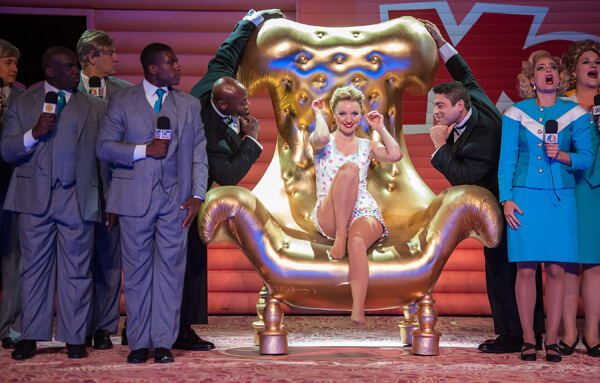 To be fair I’ll admit that as I sat voyeuristically at BAM’s Next Wave Festival last Thursday, September 19 2013, there wasn’t a single moment that I felt bored. Anna Nicole, the overblown 21st century opera by composer Mark-Anthony Turnage and librettist Richard Thomas, can be praised if nothing else than for its over-the-top, crude, and always engaging content. Thomas, who is best known for his work on Jerry Springer: the Opera, provided a quippy and thoroughly trashy libretto to accompany Turnage’s jazzy, bipolar score. The sets were quite impressive as well, with highlights including a fried chicken joint, a gentleman’s club (complete with pole dancers – but I’ll get to that aria later), and a gigantic mattress that was so big it curled up the wall (this was the nuptial bed that our heroine shared with J. Howard Marshall II, her 90-year-old billionaire second husband).
To be fair I’ll admit that as I sat voyeuristically at BAM’s Next Wave Festival last Thursday, September 19 2013, there wasn’t a single moment that I felt bored. Anna Nicole, the overblown 21st century opera by composer Mark-Anthony Turnage and librettist Richard Thomas, can be praised if nothing else than for its over-the-top, crude, and always engaging content. Thomas, who is best known for his work on Jerry Springer: the Opera, provided a quippy and thoroughly trashy libretto to accompany Turnage’s jazzy, bipolar score. The sets were quite impressive as well, with highlights including a fried chicken joint, a gentleman’s club (complete with pole dancers – but I’ll get to that aria later), and a gigantic mattress that was so big it curled up the wall (this was the nuptial bed that our heroine shared with J. Howard Marshall II, her 90-year-old billionaire second husband).

Sarah Coomes, Robert Brubaker, Sarah Joy Miller – Photo Credit Stephanie Berger
But despite the flashy trashy fun times, there were some serious limitations with this production. First and foremost, the leading role of Anna Nicole Smith seemed to be cast more based on dress size than the thing that matters most in an opera – you know, a singer’s actual voice. That isn’t to say that Sarah Joy Miller isn’t talented; she has a very nice instrument. It’s rich, smooth, and over all quite pleasant to listen to. It just didn’t have the power behind it that the part required. Perhaps director Richard Jones was afraid of casting someone who sounded too musical theater-y, but I couldn’t help but think that someone like Kristen Chenoweth would have been a better fit for the part. Miller’s voice was easily covered by the lush orchestration in a way that some of her colleagues, most notably her mother (played brilliantly by Susan Bickley), were not. Miller was most successful in the upper register, but even when her voice did project it lacked a certain pizzazz that would have made her character believable. One issue was the clarity of diction, which was obscured by the strange operatic Texas drawl she employed. All of the Texan characters mimicked the Texan accent in their vowels, but they still articulated their consonants – if they hadn’t, we really wouldn’t have been able to understand them. Miller’s vibrato was quite wide, which made it even harder to figure out what she was saying. Bickley was the most successful with this unusual diction, allowing the languid Southern vowels to inflect her melodic lines with character, but never obscuring the text. I only wished she had been given more time in the spotlight.
Some of the most stand-out musical bits of the evening came from the chorus, which was comprised of members of the New York City Opera. What they sometimes lacked in ease at selling Jones’ campy staging, they made up for in perfectly blended, well articulated singing that emphasized the humor of Thomas’s text and the lushness of Turnage’s orchestration. Other notable performances came from Rod Gilfrey, who played Anna Nicole’s lawyer/lover, and Robert Brubaker, who played her elderly billionaire of a second husband. There was also some really incredible pole-dancing.

Photo Credit Stephanie Berger
Speaking of pole-dancing, I have to give a hand to Turnage and Thomas for deigning to write a pole-dancing aria. I also have to applaud the shameless blow job scene (when Anna Nicole pays for the ranch that grandpa husband #2 buys for her). The show’s emphasis on the voyeurism and cannibalism of pop culture was also poignant, and quite artfully accomplished by the surreal, black-unitarded figures with gigantic camera heads who paraded on stage and through the audience in increasing numbers as Anna Nicole’s stardom rose to its critical mass.
Although I appreciated their daringness in expanding the idea of what an “opera” can be, there were a few things that I wasn’t on board with, content-wise. First was the strange song about raping the American Dream, featuring violent “Blurred Lines” reminiscent imagery in which, after it’s brutally raped, the American Dream asks for more. The show also presented mixed body image messages, which I thought at first were empowering but soon turned ugly. I was on board with the anti-breast enlargement surgery undertones, which came in the form of a sardonic chorus in Dr. Yes’s (Richard Troxell) creepy waiting room of “we are the breastless masses” and references to a life of hyper-objectified beauty and back pain. But in addition to these seemingly empowering messages, there was some pretty disturbing fat shaming. As Miller was changing into her fat suit back stage for the final act, a ceiling high scrim with skinny Anna Nicole was revealed, and then slowly obscured by an over-weight Anna Nicole in the same sexy position, on her back with her feet in the air, donning a scandalous corset. Only in the fat version, the solid background of the original image was replaced by a pattern of hamburgers, and her head remained the same size, giving it a warped and comic effect. This lasted for a couple of minutes, and garnered a serious amount of laughter from the audience. I unfortunately couldn’t see the humor, as the opera had made it clear that Anna Nicole’s unhealthy weight gain was a result of drug addiction and psychological distress.

Sarah Joy Miller, John Easterlin – Photo Credit Stephanie Berger
But let’s face it. I wanted to believe that Anna Nicole Smith was the tragic figure Turnage and Thomas have compared to both Marilyn Monroe and heroines of tragic operas past. I wanted to love her and feel sorry for her when she was unable to squeeze money out of her sugar-dead husband, even after having sex with him for a whole year; when her pain-killer addiction made her act like a fool on national television; when she lost her son to a drug overdose while ignorantly cuddling him, probably high as a kite herself; and eventually when she overdosed on a cocktail of prescription drugs, a fate she’d been tempting for years. But in the end, she was entirely responsible for her own downfall and I can’t summon much pity. She had neither the talent of Monroe, nor the sympathetic traits of Verdi’s venusian Violetta (La Traviata), Puccini’s pitiful Mimi (La Bohème), or even Strauss’s spunky Salome (… Salome). To me, the most fascinating thing about Anna Nicole was the fact that she became so famous on literally nothing but a knack for self-exploitation and a fresh set of bowling ball tits.
In the final scene, as our heroine lies dead on the floor, alone but for her camera-headed friends, who frantically scavenge the garbage that’s been scattered around her, we are reminded that she was just a person, and that these cameras are pretty creepy. And just before the curtain draws, the cameras turn to us and FLASH, as if to say, “who’s the camera now, bitch?”
—
NYC-based violinist Marina Kifferstein, a graduate of Oberlin College and Conservatory, is an active performer and is pursuing a Masters degree in Contemporary Performance at the Manhattan School of Music.
Anna Nicole will play at BAM until Sep. 28, 2013. For more info+tickets visit: http://www.bam.org/opera/2013/anna-nicole.
See more photos of the production…






















